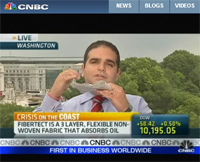
US Army highlights effectiveness of FiberTect
Fibertect Cotton-Soaking (CS), a three-layer flexible, inert, nonwoven, non-particulate decontamination system that has been proven to be successful in absorbing and adsorbing chemical warfare agents has been officially approved by the United States Environmental Protection Agency as of 29 May. According to First Line Technology, which is commercializing the product, Fibertect CS may now prove useful in recovery efforts in the British Petroleum (BP) Deepwater Horizon

2nd June 2010
Innovation in Textiles
|
Chantily, VA
 Fibertect Cotton-Soaking (CS), a three-layer flexible, inert, nonwoven, non-particulate decontamination system that has been proven to be successful in absorbing and adsorbing chemical warfare agents has been officially approved by the United States Environmental Protection Agency as of 29 May.
Fibertect Cotton-Soaking (CS), a three-layer flexible, inert, nonwoven, non-particulate decontamination system that has been proven to be successful in absorbing and adsorbing chemical warfare agents has been officially approved by the United States Environmental Protection Agency as of 29 May.
According to First Line Technology, which is commercializing the product, Fibertect CS may now prove useful in recovery efforts in the British Petroleum (BP) Deepwater Horizon disaster and other oil spills of similar size and severity. Fibertect CS was developed by Texas Tech University’s The Institute of Environmental and Human Health (TIEHH) Associate Professor Seshadri Ramkumar and is manufactured by Hobbs Bonded Fibers for First Line Technology, a supplier of solutions for first responders and the military.
The three layer structure consists of a top and bottom fabric with a centre layer of fibrous activated carbon that is needle punched into a composite fabric. The top and bottom layers are said to provide structural coherence, improving mechanical strength and abrasion resistance while the centre layer holds volatile compounds, like oil.
“Raw cotton can absorb up to 20 times its weight, but when chemically modified the material can hold more than two to three times that amount. Unlike synthetic materials like polypropylene that are currently used in many oil containment booms, Fibertect made from raw cotton and carbon is biodegradable,” Seshadri Ramkumar says.
“Fibertect has already proven to be effective in the bulk decontamination of chemical warfare agents and toxic industrial chemicals, but our proposal here is to use it to aid in the clean-up efforts in the Gulf,” said First Line Technology President Amit Kapoor, adding:
“Fibertect allows for a green, environmentally safe, biodegradable technology that is perfect for the expanding effort to protect and decontaminate coastal lands and wildlife. We welcome the opportunity to work with the government, BP, or other oil companies in a joint effort to defend and preserve our planet.”
Watch the ‘Texas Tech's Fibertect Could Help Gulf Oil Spill’ video below

Business intelligence for the fibre, textiles and apparel industries: technologies, innovations, markets, investments, trade policy, sourcing, strategy...
Find out more